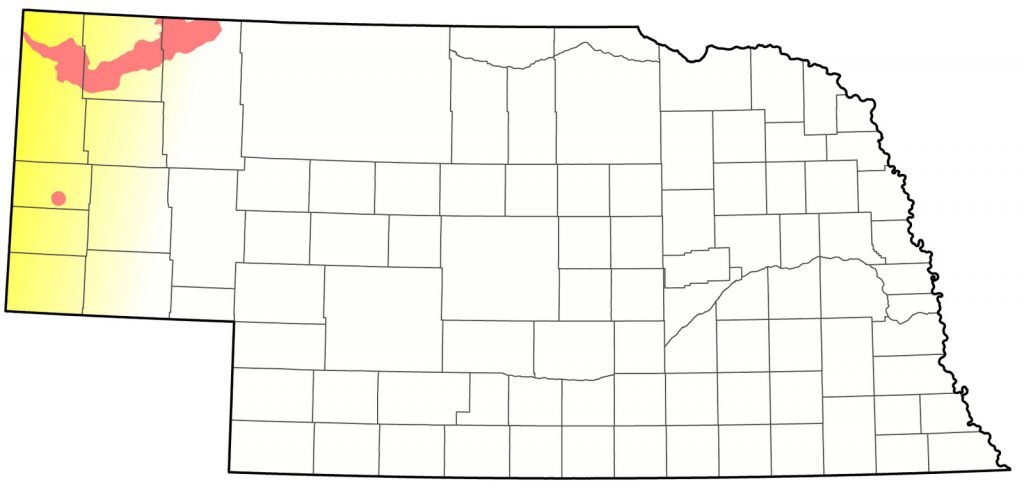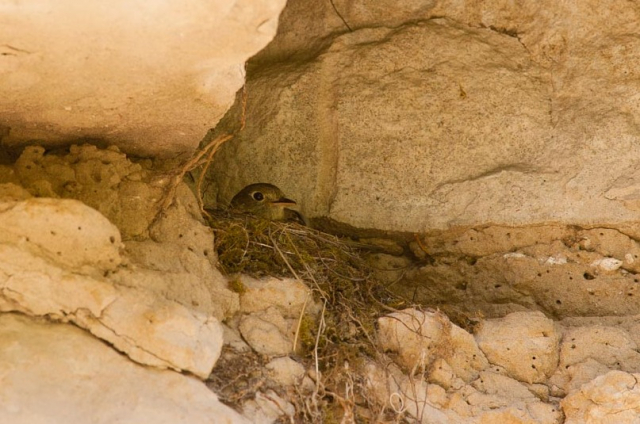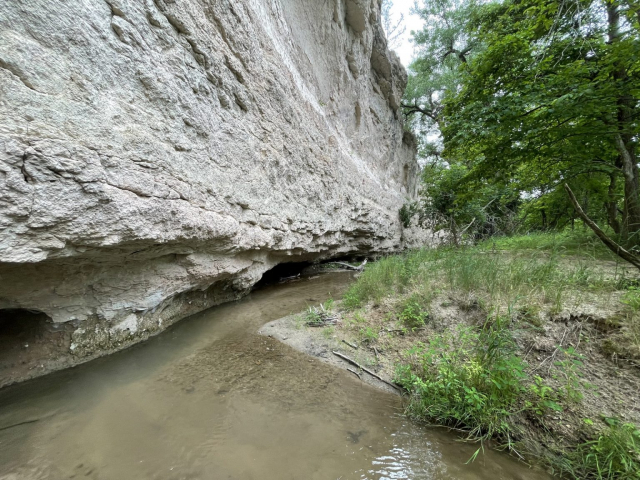Empidonax difficilis
Status: Uncommon regular spring migrant west. Rare regular fall migrant west. Uncommon regular breeder northwest.

Documentation: Recording: 9 Jul 1991 Sowbelly Canyon, Sioux Co (Grenon 1991).
Taxonomy: Five subspecies are recognized (Lowther et al 2023, AviList 2025): difficilis of the western U.S. and Canada, insulicola of the Channel Islands, cineritius of Baja California, hellmayri from southern British Columbia and southern Alberta south to northeast California and western Texas, and occidentalis of central and southern Mexico.
Nebraska birds are hellmayri.
This account includes Nebraska reports of Western Flycatcher prior to 1988 and reports of “Cordilleran” Flycatcher 1988-2023. Western Flycatcher was split into two species, Pacific-slope Flycatcher E. difficilis and Cordilleran Flycatcher E. occidentalis in 1988 (Johnson and Marten 1988) but accumulating new evidence since 1988 resulted in the two species being re-lumped in 2023 (Chesser et al. 2023).
Spring: May 15, 15, 16 <<<>>> May 28, 30. 31 (away from breeding range)
An earlier date is 13 May 1994 Dawes Co.
Late dates above are away from the Pine Ridge and the Wildcat Hills breeding range.
Later dates are 5 Jun 2020 Kimball Co, 7 Jun 2009 Gordon Cemetery, Sheridan Co, 12 Jun 2010 Crescent Lake NWR, Garden Co, and 19 Jun 2010 Wright’s Gap, Morrill Co.
- High counts: 11 in Sowbelly Canyon, Sioux Co 28 May 2020.
Summer: Until recent breeding in the Wildcat Hills, Scotts Bluff Co, Western Flycatcher was known to occur regularly as a breeder only in Pine Ridge canyons, where it is found in riparian locations with steep cliffs and shaded shrubby vegetation. It may have arrived in Nebraska relatively recently, as it was not listed by Bruner et al (1904); the first record for Nebraska was as recent as 6 Sep 1961 (Brashear 1962, Gates 1962). It has bred in the Black Hills of South Dakota since at least 1948 (Tallman et al 2002).
The observation by Rosche (1982) of a singing male in Sowbelly Canyon, Sioux Co 4 Jul 1973 is the first indication of breeding in Nebraska. The following year, on 17 Jul 1974, Rosche (1982) discovered a nest with four young in Sowbelly Canyon; this was at the same location as the 1973 sighting. Western Flycatchers have been reported from Sowbelly Canyon most summers since. Nearby Monroe Canyon has multiple individuals also; 11 were counted there 20 Jul 2000. Reports 24 Jun 1996 in the Wood Reserve, Sioux Co (Silcock and Jorgensen 1996) and 31 May 1997 in Smiley Canyon, Sioux Co and East Hat Creek Canyon, Dawes Co the same day (Silcock and Jorgensen 1997), were at locations where nesting might have occurred.
Recent years have seen expansion eastward of this species; it probably breeds throughout the Pine Ridge, east to Metcalf WMA, Sheridan Co where nest building was observed 20 Jul 2011 (Mollhoff 2016, 2022), the easternmost breeding location to date. Recent reports from Sheridan Co are from Beaver Creek 21 May 2012 and Whiteclay 28 Jun 2015.
The only nesting records away from the Pine Ridge are in the Wildcat Hills, Scotts Bluff Co; breeding occurred near the Nature Center 24 Jun 2003; nestlings were thought to be present 3 Jul. Reports have continued since in the Wildcat Hills, mostly in Wildcat Hills SRA and WMA, but also including Carter Canyon since 13 Jun-10 Jul 2022 and Cedar Canyon since 2 Jun 2925.
An intriguing survey report by an experienced observer was of single birds along Beaver Creek in remote streamside cliff habitat along the north side of the Niobrara River at Fort Niobrara NWR, Cherry Co, 13 Jul, 1 and 3 Aug 2021 (Renee Tressler, personal communication). The species appears to have been reported at the same location in 1991 and 1992. On 23 Sep 2021 Renee Tressler took photos of various freshly used nests in the cliffs and at least one resembled the typical nest of this species. Wayne Mollhoff (personal communication) commented on the nest’s structure: I pulled out pictures I took of 5 or 6 nests (some with the incubating bird ON the nest) and they pretty much look exactly like that! The bases are uniformly greenish-gray lichens, then the tops are made of what looks like the roots of threadleaf sedge (one of the common “short grass’ prairie grasses). The sedges often form the living ‘cap’ along washouts and gully banks. They’re tough and when dry, turn wiry and springy. They are a common ‘grass’ on the hard lands above and north of the river there. Hopefully, attempts will be made to get recordings and photographs to document what would be a surprising vagrant record or probably more likely an overlooked summer location. There are five “overshoot” records of this species in South Dakota away from the Black Hills, four in the northwest May-Jul and one banded 13 Sep 1992 near Aberdeen (eBird.org, accessed Nov 2023).
A good summer count was the 10 in Sowbelly Canyon, Sioux Co 13 Jun 2019.
- Breeding Phenology:
Nest building: 4 Jun-20 Jul
Eggs: 14 Jun- 20 Jul (Mollhoff 2022)
Nestlings: 3-19 Jul
Fledglings: 5 Aug
Fall: summer <<<>>> Sep 14, 14, 15
As in spring, reports away from the breeding range in fall are rare; 22 of the 24 reports, all in the Panhandle, are 15 Aug-13 Sep, with an earlier date 9 Aug 1995 (Silcock 1995) and a later date one banded 10 Oct 2008 at Wildcat Hills NC, Scotts Bluff Co.
Reports with tangible evidence, banded and/or photographed (see below), are 24-26 Aug 2002 juvenile Bushnell Cemetery, Kimball Co, 28 Aug-8 Sep 1979 Garden Co, 28 Aug and 7 Sep 2015 Chadron SP, Dawes Co, 30 Aug 2014 Chadron SP, 1 Sep 2019 Scotts Bluff Co, 6 Sep 2012 Gering Cemetery, Scotts Bluff Co, 9 Sep 1978 Garden Co, 10 Sep 2009 Chadron SP, and 13 Sep 2011 Chadron SP.
The former “Pacific-Slope” Flycatcher (E. d. difficilis) may not be unexpected in Nebraska; Tony Leukering (personal communication) pointed out that, like Cassin’s Vireo, which is more common in fall on the Colorado Plains than Plumbeous Vireo, “it is too likely that Pacific-slope could be regular” also; this led Leukering to state: “I’m not even willing to identify silent migrant Westerns”.
Images
Abbreviations
NC: Nature Center
NWR: National Wildlife Refuge
SP: State Park
WMA: Wildlife Management Area (State)
Literature Cited
AviList Core Team, 2025. AviList: The Global Avian Checklist, v2025. https://doi.org/10.2173/avilist.v2025.
Brashear, J. 1962. Excerpts from Letters. NBR 30: 14.
Bruner, L., R.H. Wolcott, and M.H. Swenk. 1904. A preliminary review of the birds of Nebraska, with synopses. Klopp and Bartlett, Omaha, Nebraska, USA.
Chesser, T.R. and others. 2023. Sixty-fourth Supplement to the American Ornithological Society’s Check-list of North American Birds. Ornithology ukad023, https://doi.org/10.1093/ornithology/ukad023
Gates, D. 1962. Fourth Report of Fall Records. NBR 30: 41-49.
Grenon, A.G. 1991. 1991 (Fourth) Report of the NOU Records Committee. NBR 59: 150-155.
Johnson, N.K., and J.A. Marten. 1988. Evolutionary genetics of Flycatchers. II. Differentiation in the Empidonax difficilis group. Auk 105: 177-191.
Lowther, P.E., D.A. McCallum, P. Pyle, and W.A. Hopping. 2023. Western Flycatcher (Empidonax difficilis), version 1.0. In Birds of the World (B. K. Keeney and S. M. Billerman, Editors). Cornell Lab of Ornithology, Ithaca, NY, USA. https://doi.org/10.2173/bow.wesfly.01.
Mollhoff, W.J. 2016. The Second Nebraska Breeding Bird Atlas. Bull. Univ. Nebraska State Museum Vol 29. University of Nebraska State Museum, Lincoln, Nebraska, USA.
Mollhoff, W.J. 2022. Nest records of Nebraska birds. Nebraska Ornithologists’ Union Occasional Paper Number 9.
Rosche, R.C. 1982. Birds of northwestern Nebraska and southwestern South Dakota, an annotated checklist. Cottonwood Press, Crawford, Nebraska.
Silcock, W.R. 1995. Fall Field Report, August-November 1995. NBR 63: 94-114.
Silcock, W.R., and J.G. Jorgensen. 1996. Summer Field Report, June-July 1996. NBR 64: 90-103.
Silcock, W.R., and J.G. Jorgensen. 1997. Spring Field Report, March-May 1997. NBR 65: 74-99.
Tallman, D.A., Swanson, D.L., and J.S. Palmer. 2002. Birds of South Dakota. Midstates/Quality Quick Print, Aberdeen, South Dakota, USA.
Recommended Citation
Silcock, W.R., and J.G. Jorgensen. 2025. Western Flycatcher (Empidonax difficilis), Version 1.0. In Birds of Nebraska — Online. www.BirdsofNebraska.org
Birds of Nebraska – Online
Updated 25 Aug 2025


